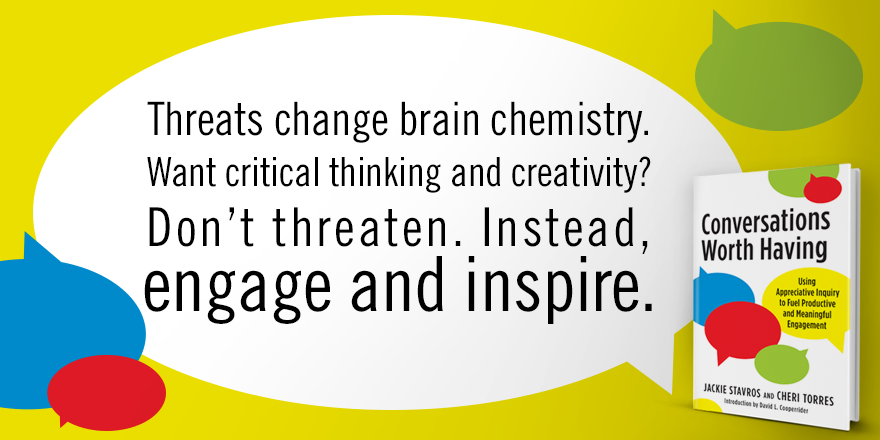Leadership Conversations
Conversations are a critical part of conducting business, of leading teams, of interacting with others.
Despite their obvious importance, how often do we think about them as a crucial skill?
Imagine if everyone on your team became exceptional at having meaningful conversations. Do you think it would translate to more wins? I’m certain of it, and that’s why I thoroughly enjoyed reading a new book by Jackie Stavros and Cheri Torres. The authors packed so much wisdom and experience into Conversations Worth Having: Using Appreciative Inquiry to Fuel Productive and Meaningful Engagement that you will find yourself referring back to it as an essential conversation reference guide.
Jackie Stavros is a professor at Lawrence Technological University; Appreciative Inquiry strategic advisor at Flourishing Leadership Institute; and an associate at Taos Institute. Cheri Torres is a Senior Consultant with NextMove and Partner at Innovation Partners International.
I recently spoke with Jackie and Cheri about their work.
The Power of a Good Conversation
Talk about the power of a good conversation.
Torres: Actually, conversation is powerful, period, whether it’s a good one or a bad one. A bad conversation can turn a good day sour, influencing interactions for hours to come. A good conversation can brighten your day and propel you into high performance and a sense of elation. When you think about it, everything arises from conversation. We’re either carrying on an internal dialogue or engaged with others, each conversation influencing what’s possible in the next moment. Conversations influence our health, wellness, happiness, relationships, performance, and what’s possible.
With their importance, why do conversations not seem to get enough attention in business?
Torres: Conversations are such an integral part of functioning in community that we take them for granted. Until recently, there was nothing drawing our attention to their importance. Research in the field of neurophysiology, however, is showing that conversations are integral to our capacity to access the executive center of our brain, the pre-fontal cortex, where higher order thinking, creativity, trust, good decision making, and the ability to connect are possible. Conversations that trigger fear or uncertainly stimulate the release of cortisol, epinephrine, and testosterone, shutting down access to the pre-frontal cortex and stimulating fight, flight, freeze, or appease. A good conversation has the power to shift the brain from threat to safety, simulating a whole different set of hormones—oxytocin, dopamine, serotonin, and endorphins. These hormones help us reconnect, open up to what others have to say, and rekindle trust. Further research in positive psychology corresponds, showing that positivity in the workplace builds resiliency, high performance, innovation, and collaboration. Organizations that have taken this research to heart and have shifted leadership and management practices are discovering the amazing power of a great conversation – a conversation worth having.
Contrast a destructive versus an affirmative conversation. What are the effects of a destructive conversation? How long do they last?
Torres: In our book, in Chapter 2: What Kind of Conversations Are You Having, we classify four different kinds of conversations. All interactions either add-value or they devalue people and situations, and all conversations are either inquiry-based or statement-based. If your questions devalue a person or situation, we refer to those kinds of conversations as “critical conversations.” If you are telling and devaluing others, we call those “destructive.” Critical and destructive conversations typically trigger a threat response in others, and we just spoke about how that impacts us. The impact of such conversations can last a long time, long after the cortisol has left the system. The reason why? Our memory stores our experience; this person is recognized as unsafe. This of course inhibits working well together.
On the other hand, if you are telling and adding value, we refer to those interactions as “affirmative conversations.” Acknowledging strengths, complementing a job well done, advocating for someone or something are examples of affirmative conversations. If you are asking questions that add value or generate value, we call those conversations worth having. Affirmative conversations will shift the brain from distrust to trust; conversations worth having will broaden and deepen that shift allowing people to bring their full value to relationships in the workplace, at home, and/or in communities.
What is appreciative inquiry and how does it relate to communication?
Stavros: Appreciative Inquiry (AI) was created by David L. Cooperrider in 1985, and today is one the most effectively and widely used approaches for fostering positive change and can easily be used to improve the outcomes of our conversations – in individuals, teams, organizations, and communities. AI is an approach that values all voices, opens our worlds to new possibilities and challenges the status quo to inspire new and innovative options to move forward.
In our book, we share two AI practices: positive framing and asking generative questions. Positive framing is about framing conversations to talk about what you want more of (instead of what you don’t want), what you wish to happen (instead of avoid), and generative questions are asking questions that allow for all voices to be heard, deepen understanding of a situation, and increase possibilities, creativity, productivity. These type of questions:
Make room for diverse and different perspectives, how do you see it?
Surface new information and knowledge, how did they manage it?
Stimulate creativity and innovation, how might we …? What might be?
AI is not about turning a blind eye to anything. It’s about seeing beyond the problem and inviting a discovery for what is going on right and what is possible – what might be that creates an empowering environment. A dose of AI in your conversations can strengthen relationships in businesses and create productivity in homes and schools – bringing out the best in people anywhere, anytime, and any situation.
This is best summarized in the final chapter of the book, Chapter 7: Any Time, Any Place, and Any Situation.
Shift a Conversation
Share an example of how to shift a conversation.
Torres: Sometimes it’s as simple as asking a question. For example, someone is complaining about how something is being handled in the office. Instead of pointing out everything that is wrong with their approach, ask, “What would you do?” “How might we handle this better?” This turns the conversation from blame and complaint to possibility and opportunity.
Stavros: A senior leader in an educational organization was complaining to an organization development (OD) consultant how faculty were not using a new learning management system to be more prepared for class and communicate more effectively with students.
The OD consultant encouraged, “Isn’t that pretty typical of faculty?” And the leader said, “Yeah, faculty always resist anything new.” Suddenly, the OD consultant realized her depreciative question, and she shifted her question, “Are there any faculty who are embracing it?” The leader brightened and exclaimed, “Yes, our management faculty are 100% on board!” That single question shifted the tone and direction of the conversation!
Name, Flip, and Frame
I appreciated the practicality of the practice “name it, flip it, and frame it.” Would you share how this works?
Stavros: It starts with naming the problem, challenge, or complaint. Then, start by flipping it – what is the positive opposite, the thing you want most to happen? Next is framing it to go beyond to discover something new or figure out what the desired outcome is – what you want more of to happen.

For example,
Mark, a manager, had a problem with one of his staff. Melissa was routinely late for weekly meetings and missed deadlines.
What is the positive opposite? Melissa is routinely on time and meets deadlines.
What would be the impact if Melissa were on time? How does it impact the whole? The team has a strong sense of cohesiveness and really values Melissa’s input and work. Performance improves while trust, mutual respect and collaboration are solid. All these help us strive for excellence.
The conversation Mark and Melissa has resulted in a simple solution, but they might never have gotten there without positive framing. It turned out all they had to do was change the meeting time, and Melissa learned to speak up about deadlines and what time and resources she needed to deliver her part. More on this type of situation and story is on pp. 52-54 in our book. The simple practice has helped thousands of people to optimally set the tone and direction of their conversations to make each of them into one worth having.
These two practices of positive framing and generative questions are woven together in an appreciative and inquiry-based interaction that results in conversations that are meaningful, productive, engaging, generate new information, knowledge, and possibilities, solution or outcome-focused, and positive.
For those who feel hardwired to one way and struggle to change, what techniques have helped?

Torres: We are all hard-wired to survive, and belonging is a key component of survival. None of us will ever change that, and we probably don’t want to. We can, however, begin to be more aware of when there is a REAL threat and when it’s a paper tiger. Feeling threatened often leads us to jump to conclusions and make stuff up without asking. Catching yourself doing that and shifting your mindset is something you can learn and practice. We recommend the following:
- Start paying attention to your patterns and recognize when you’re triggered
- PAUSE, breathe (take a short time or a long time –as much as you need to make sure you have a conversation worth having.During your PAUSE, Ask yourself questions that generate possibility, curiosity, connection, opening. For example: What’s really going on here for me? For others? What have I assumed or made up? What another possible explanation for what just happened?
Judith Glaser says the most important thing we can do with our words when we speak is to create trust. When we are transparent, put the relationship first, ask questions in order to understand, and seek shared success, we engender trust and our own brains respond. This takes courage and determination if you are coming from feeling threatened, and it is absolutely worth it because that conversation is likely to influence the rest of your day.
For more information, see Conversations Worth Having: Using Appreciative Inquiry to Fuel Productive and Meaningful Engagement.


